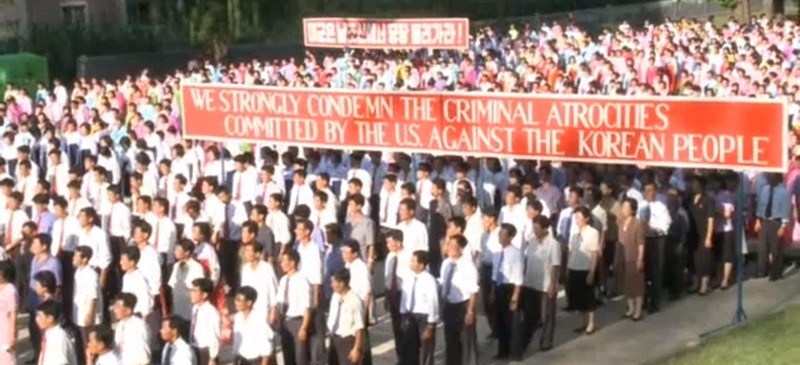
|
July 27, 2013 - No. 29 60th Anniversary of Historic Victory
|
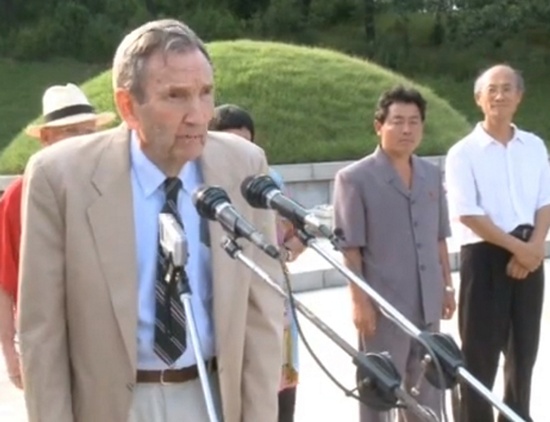 Former U.S. Attorney General Ramsey Clark |
In attendance at the international meeting were Kim Jin
Bom, vice-chairman of the Democratic Lawyers Association of Korea and
vice-chairman
of the Korean Committee for Cultural Relations with Foreign Countries,
officials and residents of Sinchon County. There was also broad
participation
by international delegates from friendship and solidarity
organizations,
international bodies and others.
Speeches were made by former U.S. Attorney General Ramsey Clark, President of the Women's International Democratic Federation Marcia de Campos Pereira, the head of the delegation of Turkey-Korea Friendship Association and Kim Jin Bom. They said that massacres of civilians by U.S. troops during the Korean War laid bare the true colours of the U.S. which presents itself as the "champion of peace and human rights."
They strongly urged the U.S. to cease its hostility and nuclear threats against the DPRK and stop interfering in the reunification process. An appeal from the participants to the peace- and justice- loving peoples of the world was read out. It called for worldwide actions to force the U.S. to apologize and provide compensation for all the crimes it committed against the Korean people.
The appeal also called for actions to demand the dismantling of the "UN Command" and withdrawal of U.S. troops from south Korea and the signing of a peace treaty with the DPRK at the earliest possible opportunity.
(TML Correspondent, KCNA)
Inauguration Ceremony of
Fatherland Liberation War
Martyrs'
Cemetery
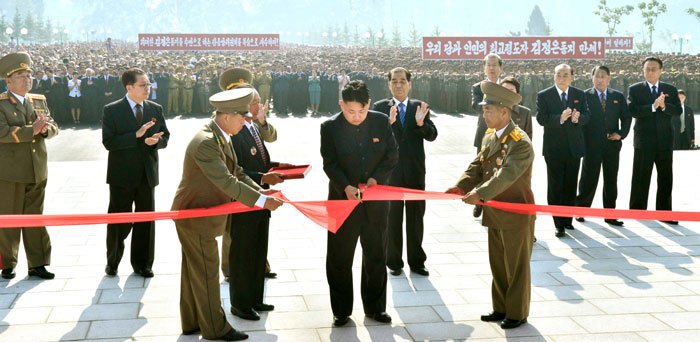
Kim Jong Un cutting ribbon at the Fatherland Liberation War Martyrs' Cemetery.
Wreath placed by Kim Jong Un at the casket of the martyrs |
The Fatherland Liberation War Martyrs' Cemetery is set on the gentle slope of a mountain on Pyongyang's outskirts. The remains of thousands of war heroes have been moved here. An image of the martyr, their name, dates of birth and death and details of their bravery adorn each gravesite, which are visible from the green valley below. In front of the cemetery, a 25-metre high red granite statue of a rifle, the flag of the Korean People's Army (KPA) and the medal of honour awarded to each hero of the Fatherland Liberation War rises from a large stone platform. Four large white granite statues depicting those who fought the U.S. aggression from 1950, forcing a ceasefire on July 27, 1953, surround the central statue. Two other magnificent statues with the dates 1950 and 1953 are set at the side of the platform.
Under a blazing sun that
reflected off the statues and
veterans' medals, a
KPA band opened the ceremony with the playing of the national anthem of
the
DPRK. A unit of soldiers in full regalia with swords and rifles marched
across
the platform in traditional high-stepping style. Kim Jong Un cut the
ribbon and
placed a wreath by the bronze casket that represents all those who gave
their
lives to defeat the U.S. aggressors. A moment of silence was held for
the
martyrs who served so valiantly.
The crowd moved forward to pay their respects at the
bronze casket then
continued up the mountain to pay personal respects to the martyrs
buried
there.
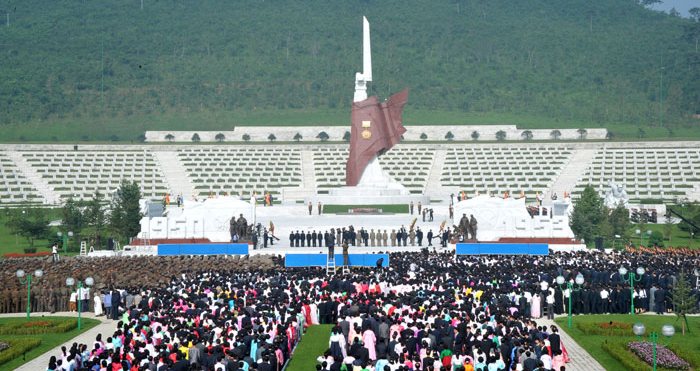
(TML Correspondent)
National Seminar on Kim Il Sung's Military Tactics

A national seminar on the military tactics of President Kim Il Sung during the Korean War was held at the Central Youth Hall in Pyongyang on July 18.
Papers presented at the seminar noted that no sooner had
the U.S.
imperialist aggressors started their surprise invasion of the DPRK than
the
President set out a strategic policy to crush the enemy forces through
a prompt
counter-attack. He set forth various strategies including the formation
of a
strong second front with regular forces and harassing the enemy's rear.
This
gave the Korean People's Army initiative in the war and turned things
around
in its favour.
The ideas of Kim Il Sung included properly combining large-unit operations with small-unit ones, regular-army warfare with guerrilla warfare and effectively conducting mountain warfare and nighttime warfare, aircraft and tank-hunting team movements, sniper team movements and other original military ideas and war methods. Despite the greater strength of the U.S. forces in practically every respect, the Korean forces shattered the myth that they were invincible.
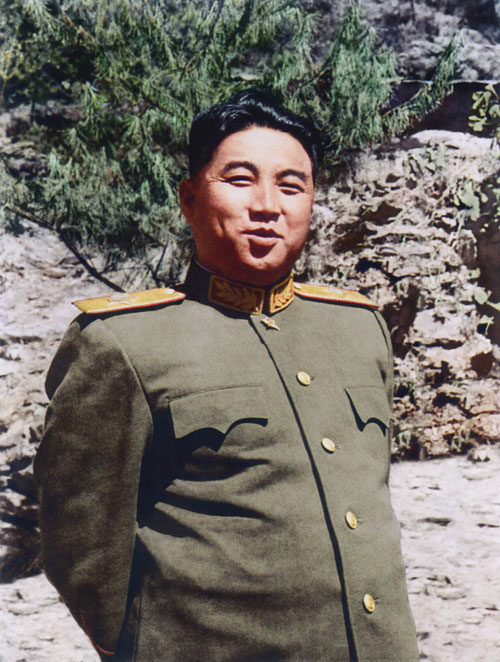 President Kim Il Sung |
The President always found the enemy's weaknesses, one speaker pointed out and used them to wipe him out. His courage and determination were without equal, he said.
He also clarified the immutable truth that the political and ideological power of the masses, not weaponry or military technology, play a decisive role in the war. He inflicted an ignominious defeat upon the U.S., the first of its kind in history, by giving fullest play to the mental power of the service personnel and people throughout the whole period of the war, the newspaper Rodong Sinmum reports.
The speakers underscored the need for all the officials, party members and other people to hold high and learn from the exploits of Kim Il Sung and the tactics of Kim Jong Il and to work hard to attain a final victory in the struggle to build a thriving socialist nation and achieve national reunification under the leadership of Kim Jong Un.
Jubilant Cultural Activities
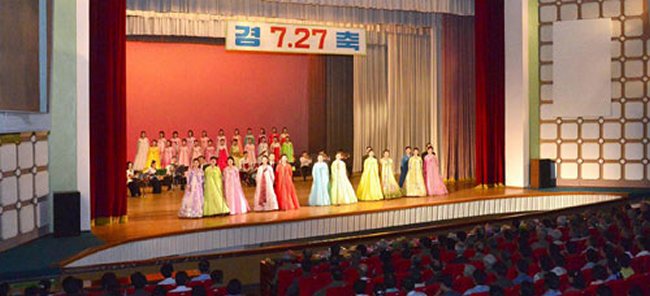
Acrobatic Perfomances
The National Acrobatic Troupe has been holding breathtaking performances as part of the anniversary celebrations. The calibre of the acrobats from the DPRK is world famous. The thrilling display of acrobatics on this occasion, entertaining thousands of spectators each day, mostly schoolchildren, shows why. It depicts the period prior to the war, the sudden attack of the U.S. imperialists in 1950, the lows and highs of the next two years on the front and in the rear, and finally the dramatic march to victory in 1953. Incredible feats of acrobatics are woven into the victory march accomplished on a grand stage where acrobats skate on ice, then suddenly when the ice rink transforms into wood, they perform the highest quality gymnastics, then fly through the air high over the stage using ropes, swings and catapults, and finally storm into the ring on six horses at full gallop with soldiers atop leading the DPRK to victory performing feats of gymnastic bravery, with the entire performance accompanied by a large youth orchestra playing patriotic and passionate music.
Grand Gymnastic, Artistic Performance "Arirang" Opens
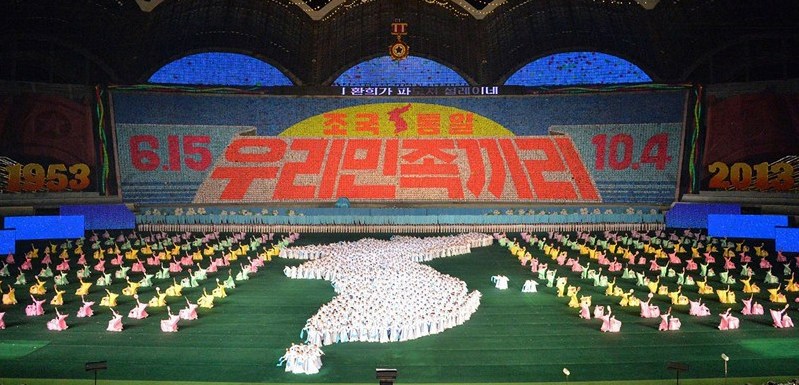
The grand gymnastic and artistic performance "Arirang," a winner of the Kim Il Sung Prize, opened in May Day Stadium on July 23 to mark the 60th anniversary of the victory in the Fatherland Liberation War.
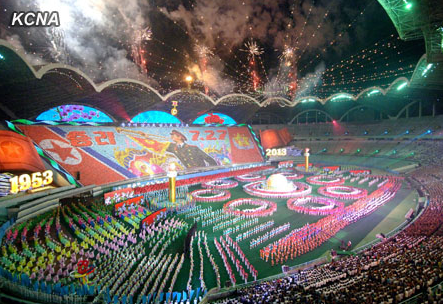 Among the audience were leaders of
the state and Workers
Party of Korea,
working people's organizations, ministries and national institutions as
well as
service personnel, people in Pyongyang, overseas Koreans and foreign
guests.
Among the audience were leaders of
the state and Workers
Party of Korea,
working people's organizations, ministries and national institutions as
well as
service personnel, people in Pyongyang, overseas Koreans and foreign
guests.
Kim Yong Jin, vice premier of the Cabinet, made an opening speech.
The display begins with the numbers "7.27" and "60" displayed on the foreground and background of the stadium as the music "Our Victory-Day July 27" resounds throughout the stadium. Spectacular scenes depicting battles waged during the Fatherland Liberation War and the legendary exploits led by Kim Il Sung during the life and death battle against first the Japanese and then the U.S. aggressors are presented. The performers also pay respects to the great war victors.
The extravaganza is imbued with national motif and is very rich in content and form. It combines music and dance with very developed artistic skill, dynamic gymnastics and acrobatics, ever-changing backgrounds, dramatic stage decor, electronic settings, lighting, etc. The effects of the colorful light rhythms, lighting and fireworks are spectacular.
The performance of Arirang is highly acclaimed by both native and foreign audiences. Many tourists visit Pyongyang to attend its performance.
Floral Exhibition
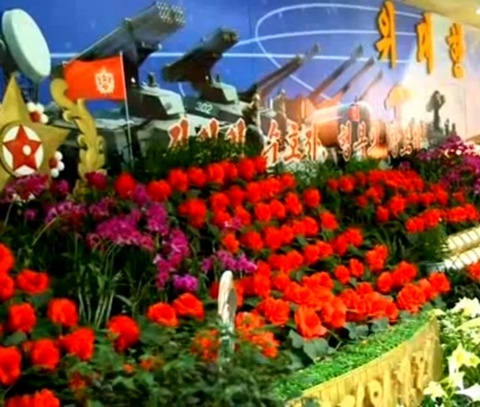
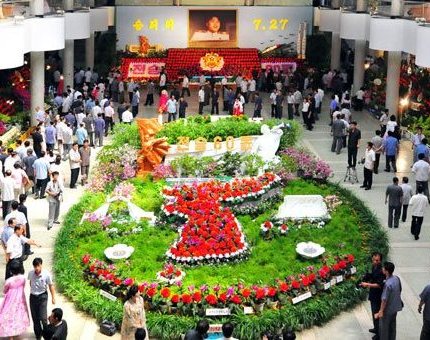
As part of the anniversary festivities, a floral exhibition opened on July 23. On display at the exhibition are more than 20,000 potted flowers, carefully cultivated by organizations from the armed forces, ministries and national institutions, as well as the Central Standing Committee of the General Association of Korean Residents in Japan (Chongryon), overseas Koreans, foreign missions and international bodies, friendship and solidarity organizations and individuals from many countries. The two varieties of flowers are known as Kimilsungia and Kimjongilia, named after the two historic leaders of the DPRK.
Stamp Exhibition

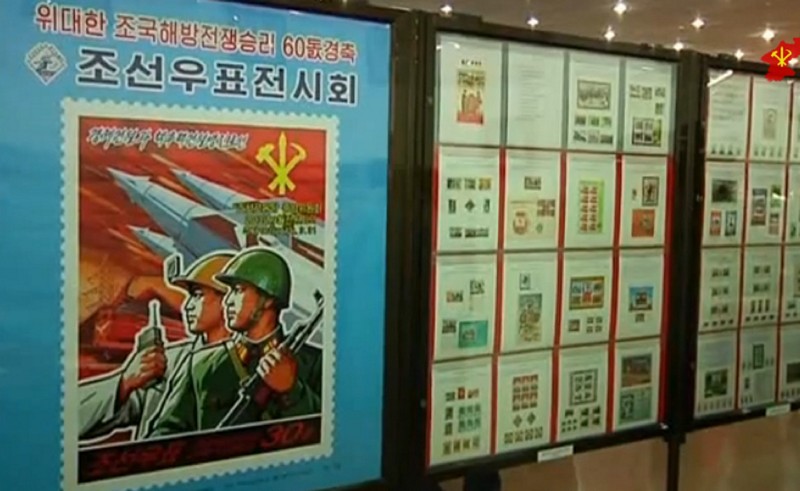
The Korean stamp exhibition opened July 23 to mark the 60th anniversary of victory in the great Fatherland Liberation War. Included are stamps portraying some of the feats of President Kim Il Sung in leading the DPRK to victory and a souvenir sheet commemorating his address to the mass rally in Pyongyang on July 28, 1953 celebrating the victory.
There are also stamps saluting the leadership of Kim Jong Il and of Kim Jong Un, who is continuing the revolutionary tradition of the Korean people.
(TML Correspondent, KCNA)
Grand Celebrations
National Mass Meeting Held on July 26

A national mass meeting was held at May Day Stadium on July 26 on the eve of the July 27 anniversary. Kim Jong Un, First Secretary of the Workers' Party of Korea (WPK), First Chairman of the DPRK National Defence Commission and Supreme Commander of the Korean People's Army (KPA), presided. Alongside him were senior officials of the WPK, the state and the army. Also present were many high level foreign dignitaries, diplomats, representatives of overseas Koreans, war veterans from Korea and China, and delegates from political parties, social organizations, ministries and national institutions, bereaved families of fallen fighters, service personnel of the KPA and Internal Security Forces, officials in the fields of science, education, art and literature, public health and media and many, many others.
KPA Vice Marshal Choe Ryong Hae, member of the Presidium of the Political Bureau of the Central Committee of the WPK and director of the General Political Bureau of the KPA, declared the meeting open.
Kim Yong Nam, member of the Presidium of the Political Bureau of the Central Committee of the WPK and President of the Presidium of the DPRK Supreme People's Assembly, gave a report to the meeting in which he recounted the DPRK's experience during the war:
The U.S. imperialists ignited the Korean War on June 25, 1950 to realize their ambition to dominate Asia and the rest of the world using the Korean Peninsula as its springboard, he said. They used the most brutal methods and means including the threat of atomic bombs. They even threw the troops of 15 other countries into the war by abusing the UN flag, he said.
"The DPRK's historic victory in the war was the victory of the Juche method of self-reliance, the outstanding strategy and tactics of President Kim Il Sung and the indomitable mental power of the army and people of the DPRK, united closely around the party and the leader," Nam pointed out.
He emphasized the fact that the U.S. imperialists sustained a heavy defeat for the first time in their more than 100-year-long history of wars of aggression and were forced to sign the Armistice Agreement. By beating back U.S. imperialism, the DPRK has become widely known as a country of heroes, he said.
Nam praised the invaluable assistance of the Chinese People's Volunteers, given despite the difficult situation they faced having just won victory in their own revolution. The internationalist example set by the Chinese People's Volunteers is a shining page in the history of DPRK-China friendship and the Korean Party and people will always remember this, Nam said.
"Today, the army and people of the DPRK are ushering in a new era, successfully carrying forward the history and tradition of victory established by Kim Il Sung and Kim Jong Il, and now carried forward by Kim Jong Un," Nam said. He affirmed that the army and people of the DPRK will continue to make advances for peace and stability on the Korean Peninsula, Northeast Asia and the rest of the world together with all progressive people who aspire to justice and value conscience.

(Rodong Sinmun)
Military Parade Shows Powerful Armed Forces
and Unity with the
People
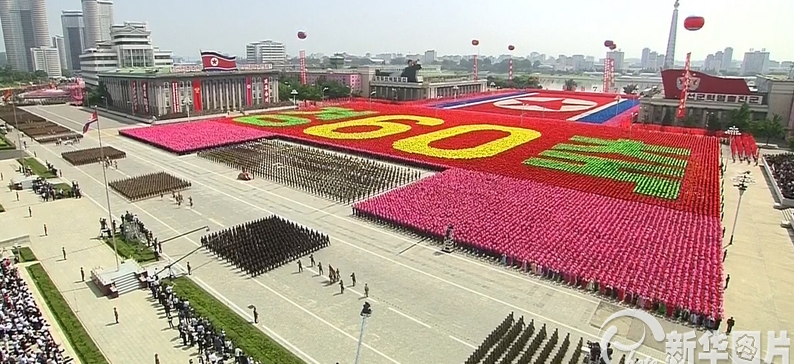
The military parade marking the 60th anniversary of the Korean War Armistice Agreement was held in Pyongyang on July 27. It was presided over by the leader of the Korean people Kim Jong Un from the podium which overlooks Pyongyang's Kim Il Sung Square. Foreign dignitaries joined Kim Jon Un on the podium as did foreign delegations who joined the people of Pyongyang at the parade.
First, wave upon wave of citizens passed in front of the podium saluting Kim Jong Un, waving flags and flowers and shouting hurrahs. This was followed by convoys of armoured vehicles and trucks carrying cannons, multiple rocket launchers and missiles. Then, contingents of the branches of the armed forces marched through the square. The grand spectacle brought to the fore the strength of the armed forces and their unity with the people. It gives serious pause for thought to any foreign forces arrogant enough to consider attacking the DPRK.
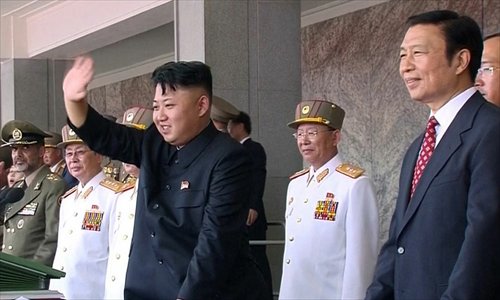 Choe Ryong Hae, director of
the General Political Bureau
of the
Korean People's Army, addressed the DPRK's desire for peace. The top
national priority of the DPRK and its military is to safeguard the
country
from foreign invasion, Choe said.
Choe Ryong Hae, director of
the General Political Bureau
of the
Korean People's Army, addressed the DPRK's desire for peace. The top
national priority of the DPRK and its military is to safeguard the
country
from foreign invasion, Choe said.
"A peaceful environment is important for the country
that gives
priority to economic construction and improvement of the lives of our
people," he added.
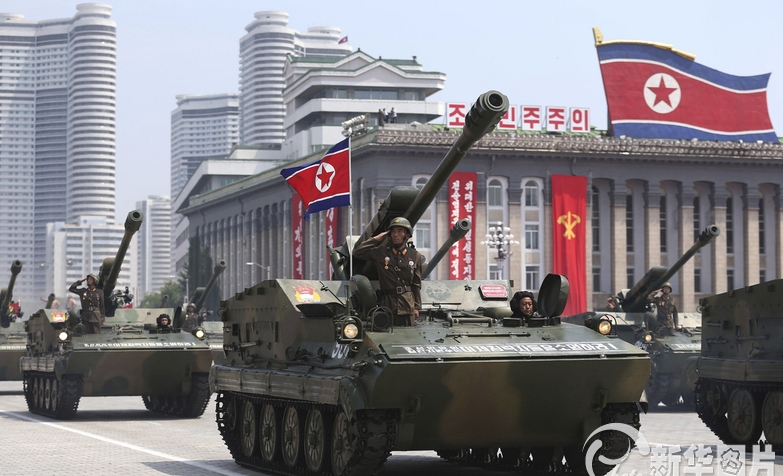
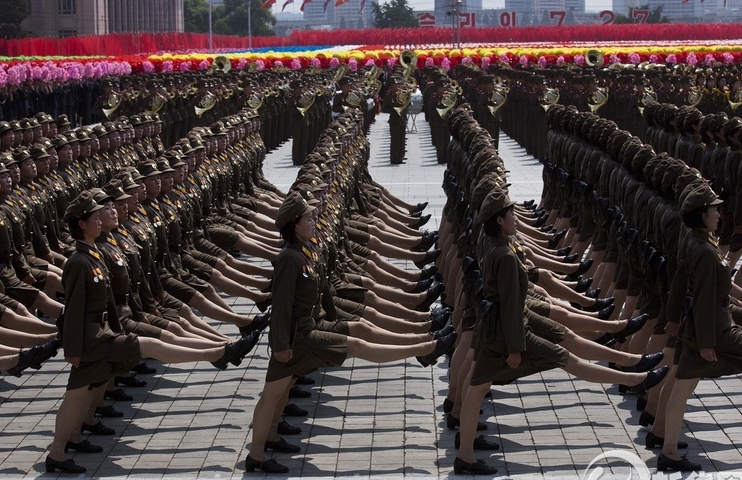
U.S. Wartime Crimes
History Society Discloses Evidence that
U.S.
Provoked Korean War
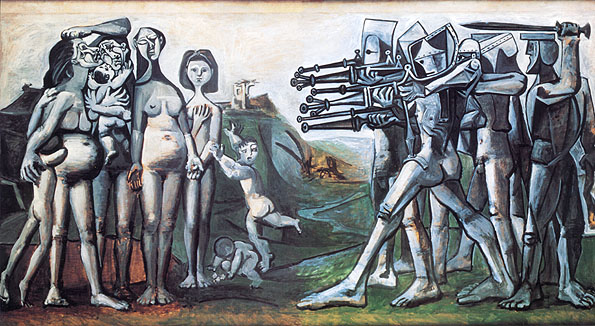
Picasso's "Massacre in Korea" (1951), depicting the 1950 Sinchon massacre of some 35,000 civilians by U.S. forces.
The History Society of the Democratic People’s Republic of Korea (DPRK) on June 24 released a memorandum disclosing the true colors of the U.S. imperialists as provoker of the Korean war. It sparked the inter-Korean confrontation and fratricidal war, the memorandum points out.
"After the Second World War the United States occupied south Korea, pursuant to its criminal policy for invading the whole of Korea and dominating the world. It divided the Korean nation into two parts, escalating confrontation between Koreans and imposing all sorts of misfortunes and sufferings upon them," the memorandum says.
The memorandum reviews the history of U.S. attempts to
take over Korea
since the 19th century. Calling Korea the "gateway to the Asian
Continent,”
the U.S. established the takeover of Korea as official state policy. In
February
1845, a law "for forcing Korea to open" itself to the U.S. was passed
by the
U.S. Congress which in 1866 followed through by sending the USS General
Sherman to invade. "It was repulsed by the struggle of the people in
Mangyongdae and soldiers and the people of the Walled City of
Pyongyang,"
the memorandum points out.
The memorandum says that this was followed by the intrusion of the warships Shenandoah and China in 1868 and the large-scale invasion in 1871 when more than 700 marines and sailors were landed on Kanghwa beach on the west side of Korea. They destroyed several forts while inflicting over 600 casualties on the defending Koreans. It was the largest U.S. military force to land on foreign soil outside of Mexico and Canada until the "Spanish American War" in 1898. Despite this, the U.S. was forced to withdraw because in order to establish their colonial rule, a much larger, permanent military presence would be necessary.
Then, from August 10-15, 1945, "the U.S. imperialists cooked up the 38th parallel under the pretext of 'the line for sharing responsibility' to receive the surrender of the Japanese Army. Their forces occupied south Korea under the mask of 'liberator' from September 8 to the end of October."
 Operational map drawn up by U.S. aggressors for invasion of the northern half of Korea |
"On September 7, 1945, the U.S. imperialists announced the establishment of a U.S. military administration across south Korea through Proclamation No. 1 of the MacArthur Command. It unreasonably brought the issue of Korea to the United Nations and cooked up a 'decision' to hold separate elections in south Korea and set up a pro-U.S. regime opposed to communism through suppression and fraud and swindle."
After the emergence of the puppet regime in south Korea, the U.S. imperialists frantically stepped up preparations to invade the DPRK, the memorandum points out.
"They built a puppet army to be used as a shock brigade for carrying out the war of aggression and rapidly beefed up its strength.
"They sent a 500-strong U.S. military advisory group, the biggest in the world at that time, to south Korea for the purpose of establishing a commanding system, forming units of the south Korean puppet army. They trained them as if they were U.S. troops."
The memorandum says that the real aim sought by the U.S. imperialists in preparing the war of aggression "was fully revealed by their process of working out and rounding off the war scenario."
Their scenario had three phases, the memorandum explains:
"Its phase A was to launch the Korean War, its phase B was to escalate the war into China and its phase C was to intrude into Siberia. The U.S. envisaged 1949 as the year to start the operation.
"In order to verify the feasibility of the war scenario the U.S. imperialists drove the south Korean puppet army keen on the 'northern expedition' to armed provocations.
"Consequently, such battles reminiscent of a real war continued in areas along the 38th parallel even on the eve of the Korean War which broke out on June 25.
"The U.S. hatched a crafty and base plot to evade responsibility for the provocation of the war against the DPRK.
"In October 1949, it cooked up at the 4th session of the UN General Assembly 'the 3rd UN Commission on Korea' whose mission was to cover up the truth about the cause of the outbreak of the Korean war by confusing right and wrong under the pretexts of monitoring and reporting 'the military dispute in Korea.'
"In the meantime, it had already worked out 'basic documents' and 'resolutions' to be presented to the meeting of the UN Security Council and the sessions of the UN General Assembly after the outbreak of the war.
"John Foster Dulles who was U.S. Secretary of Defense at the time and Chairman of the U.S. Joint Chiefs of Staff, inspected positions of the south Korean puppet army along areas south of the 38th parallel after flying into Seoul in June 1950 and finally examined the war scenario, looking at operation maps and a model board showing the operational theaters.
"He then visited General MacArthur at his command centre in Tokyo to decide whether the U.S. was ready to start the deployment of its troops in a Korean war.
"The U.S. imperialists provoked that criminal war of aggression by hurling south Korean puppet units across the 38th parallel at 4 a.m. on June 25, 1950," the memorandum points out. MacArthur, who played a main role in igniting the Korean war, admitted that the war was his plan.
"The U.S. should not forget its disgraceful history in which it was compelled to sign a document of surrender despite the fact that it mobilized huge armed forces and the latest military hardware for the war," the memorandum concludes.
(KCNA)
References
B.M. Blechman and S.S. Kaplan, Force Without
War:
U.S.
Armed Forces As A Political Instrument. Wash., D.C.: The Brookings
Institution, 1978, Appendix B;
Congressional Research Service (Foreign Affairs
and
National Defense
Division), Instances of United States Armed Forces Abroad,
1798-1993. Wash., D.C.: Congressional Research Service, 1993;
William Blum, Killing Hope: U.S. Military
and CIA
Intervention
Since World War II. Monroe, ME: Common Courage Press, 1995;
John Stockwell, The Praetorian Guard.
Cambridge, MA:
South End Press, 1991;
William Blum, Rogue State. Monroe, ME:
Common
Courage
Press, 2000;
Stephen Endicott and Edward Hagerman, The
United
States
and
Biological
Warfare:
Secrets
From the Early Cold War
and Korea. Bloomington, IN: Indiana University Press, 1998.
Jurists Society Discloses U.S. Wartime Crimes
The Jurists Society of the Democratic People's Republic of Korea (DPRK) issued a memorandum disclosing the crimes committed by the U.S. imperialists during the Korean war.
The memorandum released on July 19 cited facts that prove the U.S., as the chief culprit of the aggression and war, tried to cover up its role as the instigator of the war, drawing in its troops and the armies of its satellite countries.
The UN Security Council's "resolution" on the Korean war was illegal as it was not based on investigation into the truth about the dispute, the jurists' memorandum said.
The jurists point out that the "resolution" was adopted in contravention of article 32 of the UN Charter -- which calls for parties to the dispute to be present at the discussions of the problems -- and paragraph 3 of article 27 of UN Charter, which provides that a Security Council resolution is only valid if approved by a vote of Council members, including approval by all permanent Council members.[1] Neither condition was met.
Furthermore, the U.S. committed atrocities in breach of war legislation and custom, they jurists add.
During the war the U.S. dropped more than 428,000 bombs
over
Pyongyang on 1,400 occasions, destroying industrial establishments,
education,
health and public service facilities and homes, killing many civilians.

Pyongyang after the war.
One hundred U.S. bombers that flew over Sinuiju on November 8, 1950 dropped bombs that levelled 8,900 houses, killed over 9,000 people and wounded 3,155.
On September 16, 1950 when the U.S. forces landed at Inchon, they killed more than 1,300 civilians and arrested or killed over 75,000 patriots in Seoul alone.
A little over one year into the war, the U.S. had massacred one million civilians in south Korea.
During the U.S. temporary control of areas in the northern half of Korea, its forces massacred a broad section of innocent people in the most horrific manner. People were buried alive, dismembered, burned to death or drowned in rivers and seas, including party and government officials, members of working people's organizations, workers, farmers, office workers, youth and students and even clergy people, regardless of their sex and age.
The U.S. created fear that it would use nuclear weapons
to scare people
to the south, then attacked those that fled, killing over 4,000 at the
makeshift
bridge over the Taedong River and on the frozen river itself, and more
than 30,000 along the Sariwon-Haeju road.
When forced to retreat from the north, the U.S. imperialist aggressors deployed biological weapons as they withdrew, spreading all kinds of infectious viruses, including smallpox. The number of those who contracted infectious diseases rapidly increased to 3,500 in April 1951, 10 per cent of whom died.
From early January to March 1952, the U.S. used germ warfare via bombs it dropped on 169 areas in the northern half of Korea, including highlands, coasts and mountains, a total of 804 times.
In May 1952, the U.S. flew hundreds of planes over the DPRK every day and a quarter of them dropped bombs carrying germs. The number of flights reached over 480 a day at its peak.
The use of poisonous gas by the U.S. began with its indiscriminate bombing on Nampho on May 6, 1951, where 1,379 people died as a result.
There are other examples of the atrocities committed by
the U.S.
imperialists during the Korean War in wanton violation of the laws and
customs governing war. They were not accidental acts by individual
American
soldiers but hideous and enormous crimes committed as part of an
organized
plan to carry out U.S. government policy.


Left: A long line of refugees fled Yongdong, South Korea, on July 26, 1950. The same day, eight miles down the road at No Gun Ri, hundreds of refugees came under fire from U.S. troops. A letter has come to light indicating the killings were
part of U.S. policy. Right: In this undated photo suspected communist collaborators were rounded up in Yongdong.
(Naenara News)
Note
1. The USSR, a permanent member of the Security Council was not present at the meeting which "passed" the resolution authorizing the aggression in Korea. Meanwhile, the UN had not yet recognized the People's Republic of China and China's permanent seat on the Council was still held by the reactionary Kuomintang government of Chiang Kai-shek, despite it having lost the civil war and fleeing to the island of Taiwan.
Canada's Role in Korean War
On July 27, Julian Fantino, Minister of Veterans Affairs, led a delegation to Seoul of Canadian veterans who participated in the U.S.-led imperialist aggression against Korea. As part of the activities there to mark the 60th anniversary of the end of the Korean War, Fantino unveiled "a new Canadian monument dedicated to the Canadian Armed Forces personnel who fought during the Korean War and to those who served after the Armistice between 1953 and 1957."
The government of Canada has declared 2013 the "Year of the Korean War Veteran" and says that "Canada proudly remembers the heroes of the Korean War and their brave fight to uphold freedom, democracy and the rule of law." A statement issued by the Department of Foreign Affairs says that Minister Fantino's trip to Korea "recognizes the contributions of all Veterans who came to the aid of the people of South Korea more than 60 years ago."
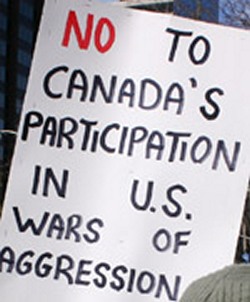 This is not the conduct of a country which
has
established
diplomatic relations with both the Republic of Korea and the
Democratic People's Republic of Korea in order to overcome the
past, contribute to the reunification of the Korean nation and to
the cause of peace on the Korean Peninsula. In fact, the uncouth
behaviour of the aggressor was evident when Fantino showed no
mercy towards the ten million Korean families that remain divided
as a result of the U.S. division of Korea at the 38th parallel
and its refusal to stop interfering in Korean efforts at
reunification. "While the horrors and hardships of the Korean War
may seem distant," Fantino said, "the legacy of our Canadian
Veterans remains strong in the form of a free, democratic and
prosperous Korea."
This is not the conduct of a country which
has
established
diplomatic relations with both the Republic of Korea and the
Democratic People's Republic of Korea in order to overcome the
past, contribute to the reunification of the Korean nation and to
the cause of peace on the Korean Peninsula. In fact, the uncouth
behaviour of the aggressor was evident when Fantino showed no
mercy towards the ten million Korean families that remain divided
as a result of the U.S. division of Korea at the 38th parallel
and its refusal to stop interfering in Korean efforts at
reunification. "While the horrors and hardships of the Korean War
may seem distant," Fantino said, "the legacy of our Canadian
Veterans remains strong in the form of a free, democratic and
prosperous Korea."
In fact, the uncouth behaviour of the aggressor was evident when Fantino showed no mercy towards the ten million Korean families that remain divided as a result of the U.S. division of Korea at the 38th parallel and its refusal to stop interfering in Korean efforts at reunification. "While the horrors and hardships of the Korean War may seem distant," Fantino said, "the legacy of our Canadian Veterans remains strong in the form of a free, democratic and prosperous Korea."
All of it is geared to perpetuate the U.S. disinformation surrounding the Korean Fatherland Liberation War and justify its war mongering today. A statement by the Prime Minister says, "Let us never forget those who served Canada (in the Korean War) with pride, nor the men and women who continue to serve our country today."
It was the U.S. that unilaterally divided Korea following the Japanese surrender in August 1945, and subsequently ruled with a military occupation government in the south, overseeing the elimination of virtually the entire popular movement of (majority) opposition to U.S. occupation, murdering hundreds of thousands of people. The consequent Korean civil war that openly raged in 1948-1950 was completely ignored when the U.S. defined the beginning of the Korean War in 1950, accusing the north of launching aggression "against the south" as a pretext for a U.S. invasion, which was fraudulently carried out under the auspices of the United Nations.
Canada was one of the 15 countries which joined forces with the U.S. in that war of aggression contributing more than 26,000 troops of which 516 were killed. Approximately 7,000 Canadians remained in Korea after the Armistice Agreement was signed, until the end of 1955, with some troops remaining until 1957.
Today Canada continues to engage in provocations which endanger peace on the Korean Peninsula. It blames the DPRK for the danger of war when it is the U.S. which remains at war with the DPRK because it has never signed a peace treaty. Its continued belligerence directed at the DPRK includes regular joint military exercises with South Korean military forces aimed at the DPRK. The U.S. retains more than 37,000 military troops at 100 installations south of the 38th parallel. It has its largest Asian bombing range in south Korea where it practices bombing five days a week, fifty-two weeks a year, despite opposition from the South Korean people. Former U.S. President Bush declared the DPRK to be part of an "axis of evil" targeted for nuclear attack. In violation of the Armistice Agreement, the U.S. not only maintains its military occupation in the south, but also nuclear weapons on ships and planes in the Pacific region surrounding the DPRK.
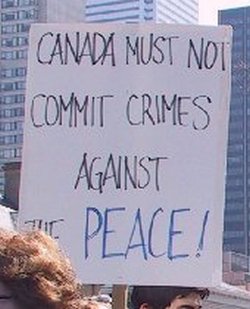 For the government of Canada to
speak of the brave fight
of
Canadian veterans "to uphold freedom, democracy and the rule of
law" makes a mockery of the striving of humanity, including the
majority of these veterans, to contribute to the cause of peace,
freedom and democracy. The "cause of peace, freedom and
democracy" Canada contributed to during the Korean war was such
that the DPRK was virtually destroyed. U.S. General Curtis LeMay
was General Douglas MacArthur's Strategic Air Commander during
that war. Earlier he led the continuous incendiary bombings of
Japan from March 10-August 15, 1945 that destroyed 63 major
cities and murdered a million citizens (more than were
subsequently killed in the atom bombs dropped on the cities of
Nagasaki and Hiroshima). Eight years later, after destroying 78
cities and thousands of villages in the DPRK, and killing
countless numbers of her civilians, LeMay remarked, "Over a
period of three years or so we killed off -- what -- twenty
percent of the population." It is now believed that the
population north of the imposed 38th Parallel lost nearly a third
its population of 8 to 9 million people during the 37-month long
war from 1950-1953.
For the government of Canada to
speak of the brave fight
of
Canadian veterans "to uphold freedom, democracy and the rule of
law" makes a mockery of the striving of humanity, including the
majority of these veterans, to contribute to the cause of peace,
freedom and democracy. The "cause of peace, freedom and
democracy" Canada contributed to during the Korean war was such
that the DPRK was virtually destroyed. U.S. General Curtis LeMay
was General Douglas MacArthur's Strategic Air Commander during
that war. Earlier he led the continuous incendiary bombings of
Japan from March 10-August 15, 1945 that destroyed 63 major
cities and murdered a million citizens (more than were
subsequently killed in the atom bombs dropped on the cities of
Nagasaki and Hiroshima). Eight years later, after destroying 78
cities and thousands of villages in the DPRK, and killing
countless numbers of her civilians, LeMay remarked, "Over a
period of three years or so we killed off -- what -- twenty
percent of the population." It is now believed that the
population north of the imposed 38th Parallel lost nearly a third
its population of 8 to 9 million people during the 37-month long
war from 1950-1953.
(Department of Foreign Affairs; Richard Rhodes, "The General and World War III," The New Yorker, June 19, 1995, p. 53.)
Read The Marxist-Leninist Daily
Website: www.cpcml.ca
Email: editor@cpcml.ca
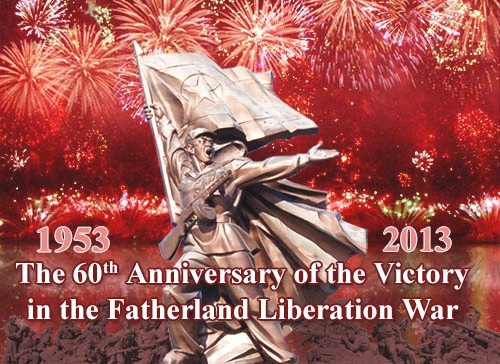
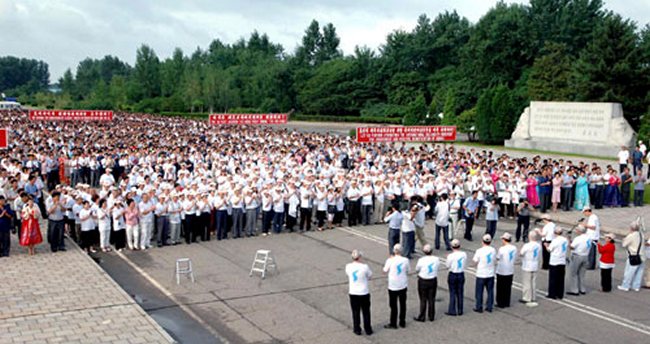
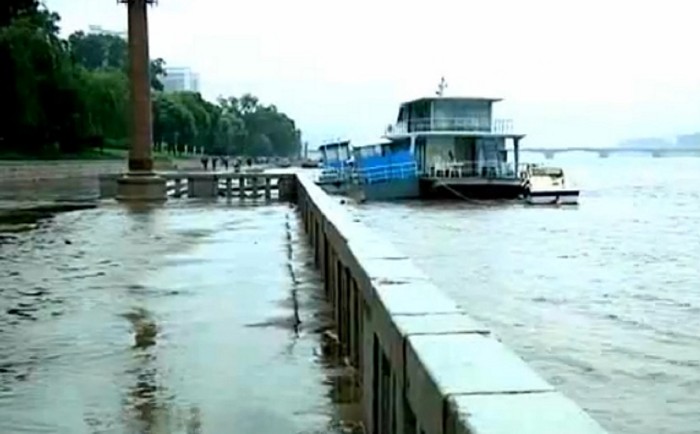 damage especially along the river
banks of
the
two main waterways in the city. After only two days, workers had washed
away the mud and debris from the city's many beautiful riverside parks
and walkways. Kim Il Sung Square and the city's wide streets with their
lovely green boulevards and spacious sidewalks were brimming with life
in
the bright July sun. Everyone was either working, purposefully heading
somewhere or simply enjoying the warm summer days.
damage especially along the river
banks of
the
two main waterways in the city. After only two days, workers had washed
away the mud and debris from the city's many beautiful riverside parks
and walkways. Kim Il Sung Square and the city's wide streets with their
lovely green boulevards and spacious sidewalks were brimming with life
in
the bright July sun. Everyone was either working, purposefully heading
somewhere or simply enjoying the warm summer days.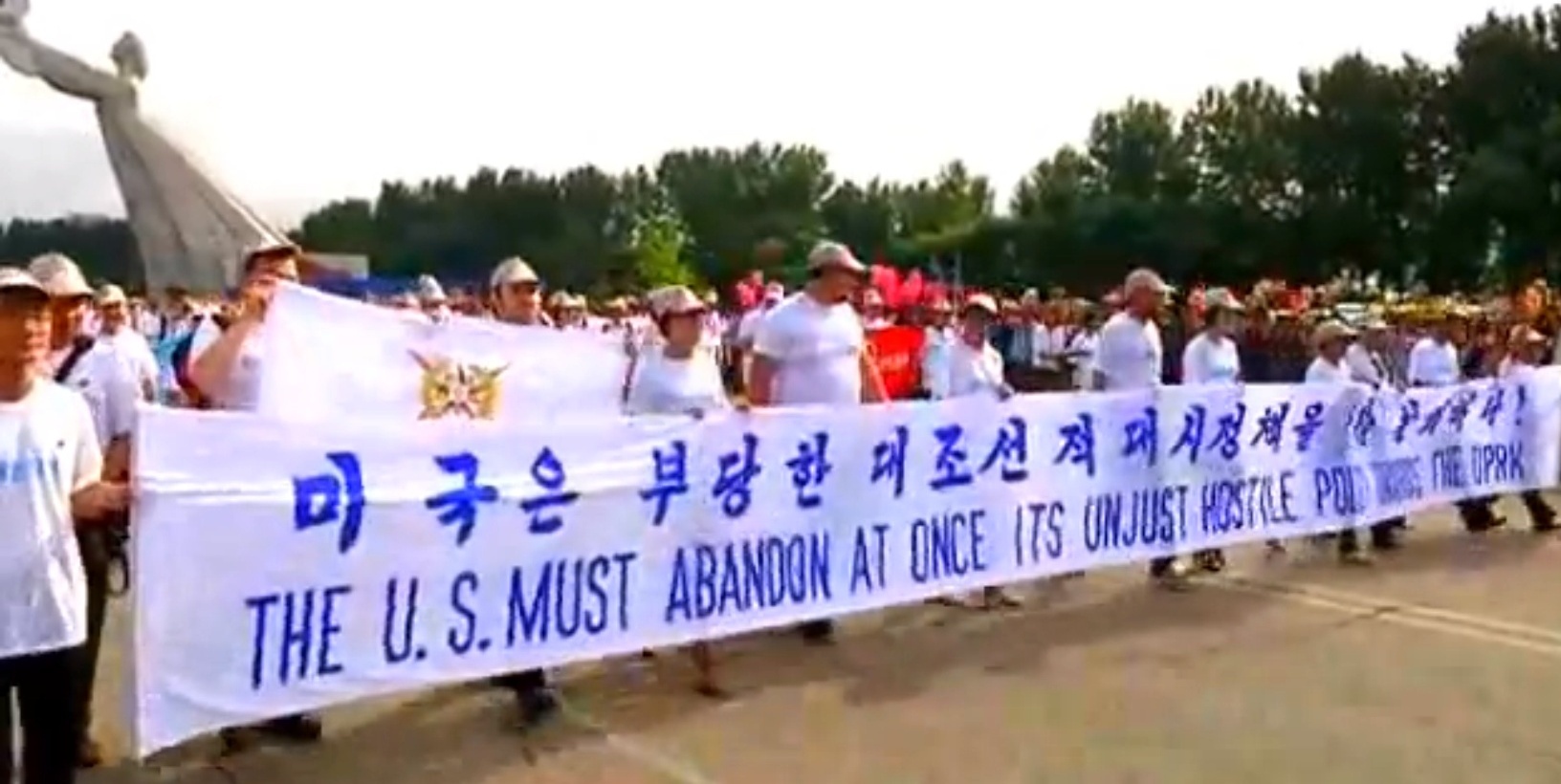

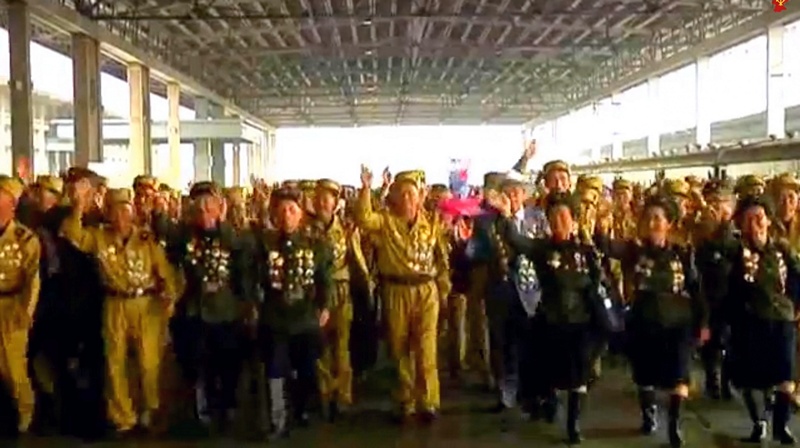


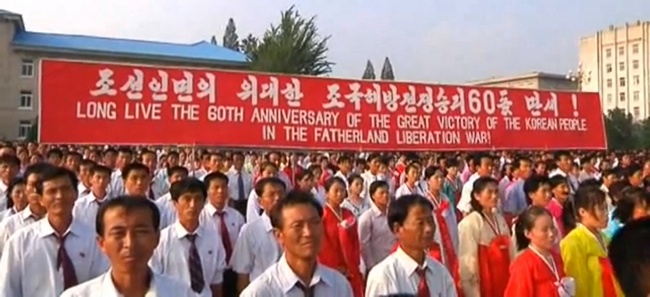
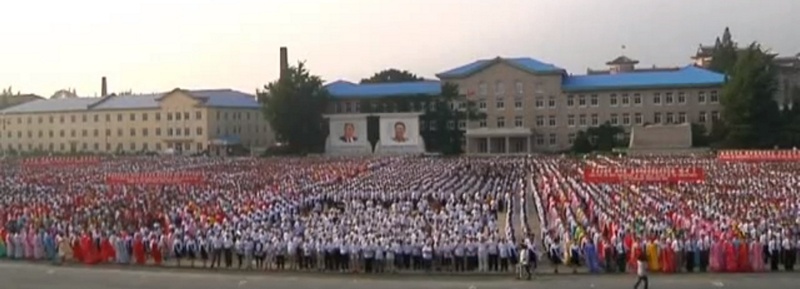
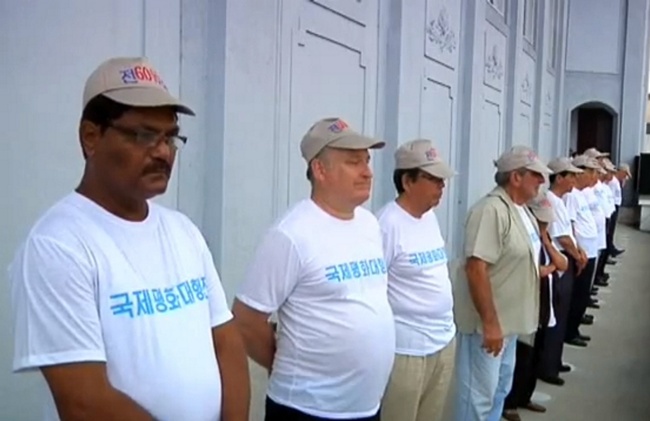 They spoke of their visit to
Panmunjom, located at the
line that
divides the two Koreas and the site where the Armistice Agreement was
signed 60 years ago. They expressed how deeply they felt the suffering
of
the Korean people due to the division of the nation and how the
experience crystallized for them why Korea remains divided. The fact
that
the Armistice Agreement was signed north of the 38th parallel
underscores the fact that it is the U.S. which was forced to surrender,
not
the DPRK. A permanent structure was built there for that express
purpose
so that the U.S. could not get away with telling lies about its defeat
in the
war.
They spoke of their visit to
Panmunjom, located at the
line that
divides the two Koreas and the site where the Armistice Agreement was
signed 60 years ago. They expressed how deeply they felt the suffering
of
the Korean people due to the division of the nation and how the
experience crystallized for them why Korea remains divided. The fact
that
the Armistice Agreement was signed north of the 38th parallel
underscores the fact that it is the U.S. which was forced to surrender,
not
the DPRK. A permanent structure was built there for that express
purpose
so that the U.S. could not get away with telling lies about its defeat
in the
war.